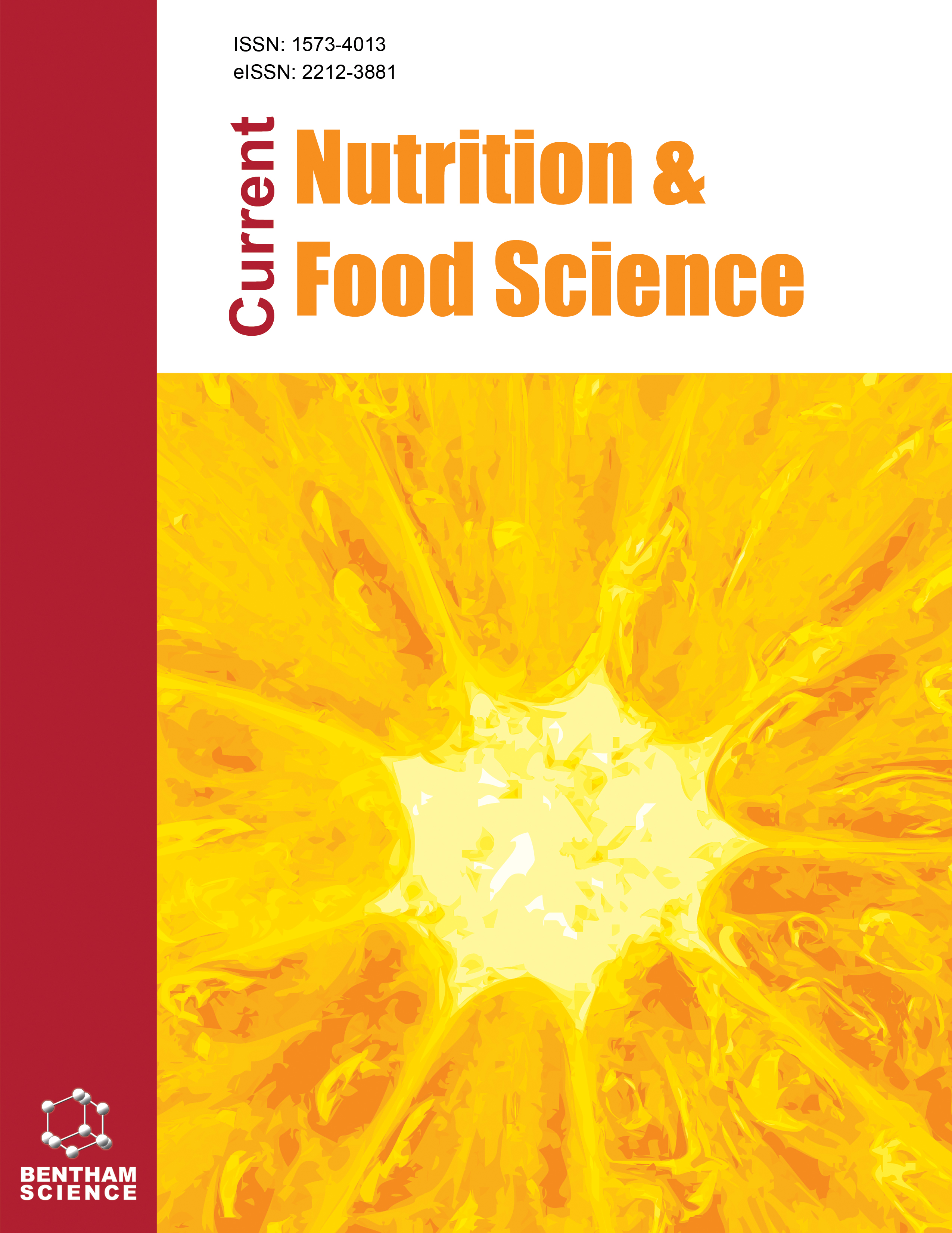- Home
- A-Z Publications
- Current Nutrition & Food Science
- Previous Issues
- Volume 15, Issue 1, 2019
Current Nutrition & Food Science - Volume 15, Issue 1, 2019
Volume 15, Issue 1, 2019
-
-
Versatile Health Benefits of Catechin from Green Tea (Camellia sinensis)
More LessBackground: Tea (Camellia sinensis, Theaceae) is the second most consumed beverage in the world. Green tea is the least processed and thus contain rich antioxidant level, and believed to have most of the health benefits. Methods: We commenced to search bibliographic collection of peer reviewed research articles and review articles to meet the objective of this study. Results: From this study, we found that the tea bevera Read More
-
-
-
The Important Role of Potatoes, An Underrated Vegetable Food Crop in Human Health and Nutrition
More LessAuthors: Umesh C. Gupta and Subhas C. GuptaDespite frequently being described as a carbohydrate-laden, calorie-rich unimportant part of the human diet, potatoes (Solanum tuberosum L.) are one of the most nutritive vegetable food crops in the world and, in comparison to most other vegetables are richer in essential human nutrients. These include proteins, starch and fibre, major, secondary and trace minerals, vitamins, antioxidants and phytochemicals. Potatoes hav Read More
-
-
-
Probiotics and Prebiotics as Functional Foods: State of the Art
More LessAuthors: Amin M. Khaneghah and Yadolah FakhriFoods, besides their nutritional value, are used to be as a tool in maintaining of physical and mental well-being and prevent disease. Based on the definition of Functional foods as foods, which may offer health benefits beyond basic nutrition, functional foods, are categorized as foods, not medicine. Among the last decades, the growing market for functional foods, representing both opportunities and challenges to food pro Read More
-
-
-
Impacts of Vending Practices on the Microbiological Quality of Bread in the Ojoo Area of Ibadan, Oyo-State, Nigeria
More LessBackground: Bacterial counts in ready-to-eat foods are a key factor in assessing the microbiological quality and safety of food. Periodic assessment of the microbiological quality of food is necessary to develop a robust database and help to ensure food safety. Methods: The bacterial contamination of a total of 336 bread samples collected from two bakeries and 10 vendors in Ojoo Area of Ibadan, Oyo-State, Nigeria (D Read More
-
-
-
Effects of Fermentative Factors on Biochemical, Microbiological and Sensory Characteristics of Probiotic Iranian Fermented Milk (Doogh)
More LessAuthors: Elaheh Ahmadi, Reza Mohammadi, Sara Hasanvand, Milad Rouhi, Amir M. Mortazavian and Zahra SarlakBackground: Doogh is a traditional Iranian fermented milk drink that is currently a very popular product in Iran. In the present study, the combined effects of incubation temperature, type of starter culture, and final pH of fermentation on the viability of two probiotic strains (Lactobacillus acidophilus La-5 (A) and Bifidobacterium lactis Bb-12 (B)) and biochemical and sensory characteristics of probiotic Doogh were investiga Read More
-
-
-
Effect of Processing and Frozen Storage on the Phenolic Profile, Bioative Compounds, Antioxidant Capacity, and Enzymatic Activity of Mangaba Pulp
More LessBackgound: The mangaba, an exotic fruit of the Brazilian Cerrado, has high nutritional and bioactive value, but processing can induce changes to these characteristics. Objective: Evaluate the stability of the bioactive compounds and the antioxidant and enzymatic capacity of mangaba pulp subjected to pasteurization, freezing methods, and prolonged storage. Method: The pulps were submitted to two levels of pasteurization Read More
-
-
-
Impact of Fat Replacement by Core-shell Microparticles on Set Type Yoghurts: Study of Their Physicochemical, Textural and Microstructural Properties
More LessBackground: Core-shell micro and nanoparticles can be used to encapsulate bioactive or functional components and to replace fat content also, since they are able to mimic the organoleptic characteristics of the fat globules. Objective: The aim of this study was to investigate the effect of replacing milk fat matter by core-shell microparticles in set type yoghurt. Method: Microparticles were produced by electrostatic depositi Read More
-
-
-
Effects of Nannochloropsis Fed on Serum and Tissue Lipids Metabolism in Obese Offspring of Overfed Dams
More LessBackground: The present work aims at determining the effects of maternal-diet-induced obesity on offspring metabolism. The short-term of a marine microalgae diet and its effects on lipids metabolism was investigated. Method: Before gestation, some rats are fed control diet and others cafeteria diet. Moreover, two groups of dams were fed standard and cafeteria diets, and two other groups were fed the same diets but Read More
-
-
-
In Vitro Estimation of Photo-Protective Potential of Pomegranate Seed Oil and Development of a Nanoformulation
More LessAuthors: Surbhi Dhawan and Sanju NandaBackground: Since ancient times, people have been using natural resources for photoprotection purposes. One such highly recognised natural agent is pomegranate seed oil, considered as wonder oil owing to the presence of several beneficial phytoconstituents. Objective: The study aimed to establish the photoprotective potential of pomegranate seed oil through various in vitro and biochemical studies along with the forma Read More
-
Volumes & issues
-
Volume 21 (2025)
-
Volume 20 (2024)
-
Volume 19 (2023)
-
Volume 18 (2022)
-
Volume 17 (2021)
-
Volume 16 (2020)
-
Volume 15 (2019)
-
Volume 14 (2018)
-
Volume 13 (2017)
-
Volume 12 (2016)
-
Volume 11 (2015)
-
Volume 10 (2014)
-
Volume 9 (2013)
-
Volume 8 (2012)
-
Volume 7 (2011)
-
Volume 6 (2010)
-
Volume 5 (2009)
-
Volume 4 (2008)
-
Volume 3 (2007)
-
Volume 2 (2006)
-
Volume 1 (2005)
Most Read This Month
Article
content/journals/cnf
Journal
10
5
false
en


